The Google Nexus 6P Review
by Andrei Frumusanu on December 16, 2015 8:00 AM ESTSystem & CPU Performance
The Nexus 6P comes with a Snapdragon 810 designed by Qualcomm. This is a big.LITTLE 4x A53 @ 1.55GHz + 4x A57 @ 1.95GHz SoC. As we’ve hopefully come to be very familiar with the chipset over the last couple of months, the key characteristics with which the 6P can differentiate itself from other Snapdragon 810 devices is through software optimizations. In particular the fact that the Nexus 6P comes with Android 6.0 Marshmallow should allow it to be able to showcase some improvements which we’ll dive into a bit later.
First we start by comparing performance of some of our browser-based benchmarks. These are predominantly Javascript tests which require large single-core performance out of the device’s SoCs.
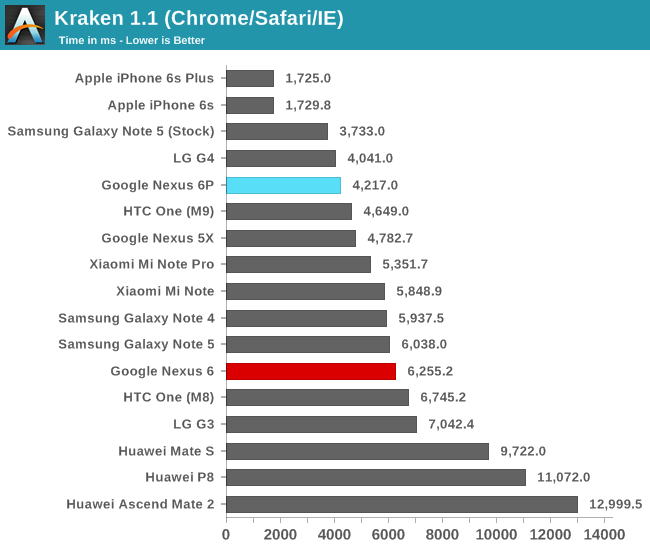
In Kraken the Nexus 6P is able to showcase a very good score that’s only beat by, oddly enough, the LG G4. As we’ve come to discover over the past year OEM browser libraries play a large role in device performance, even though we’re using the same Chrome build across different devices we see large differences in performance even within devices who employ the same SoC. It’s relatively unnerving to see this fragmentation in the ecosystem and in particular Chrome performing so differently across devices.
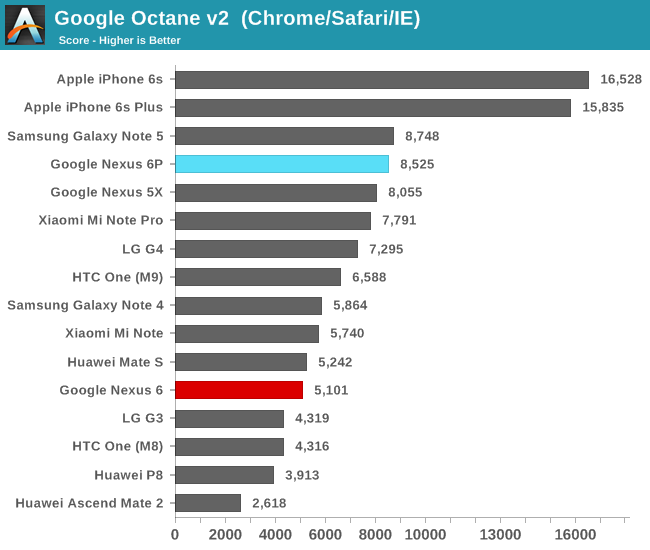
In Octane the Nexus 6P again performs very well, this time again beating our other devices such as the HTC One M9 or the Xiaomi Mi Note Pro. Among Android devices, only the Galaxy Note 5 - which on Octane is able to show equal performance as it does in its optimized stock browser - is able to beat it.
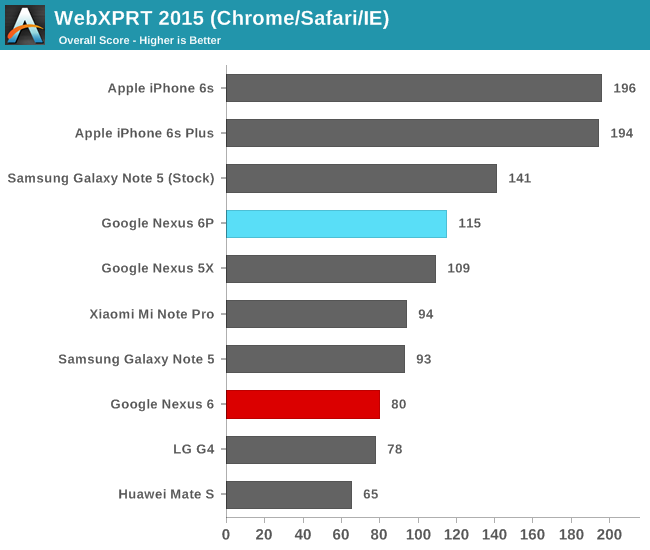
On WebXPRT again we see the 6P performs extremely well among Android devices, only being able to be beat by Samsung’s Exynos 7420 devices in the stock browser.
Continuing onto our system benchmarks, we start with Basemark OS II 2.0 from Basemark (formerly Rightware).
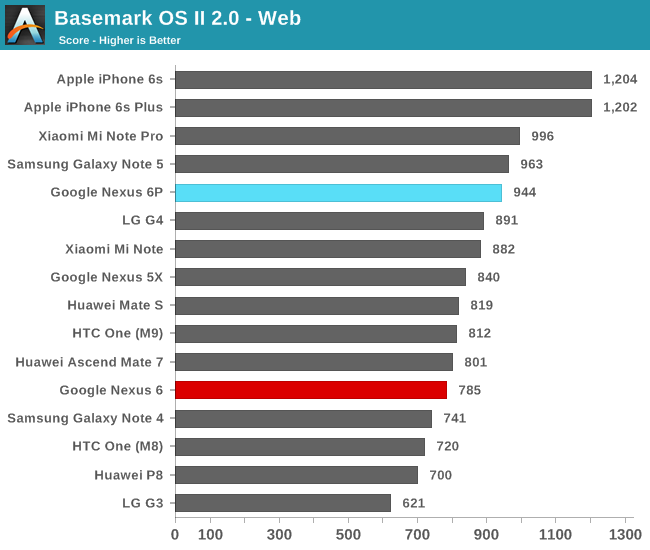
In the web test the Nexus 6P is yet again found at the high-end of the charts as it is able to provide good numbers. As we’ve seen in reviews such as on the Mate S it’s not necessarily raw performance that is demanded in these tests but also performance latency which plays a big role.
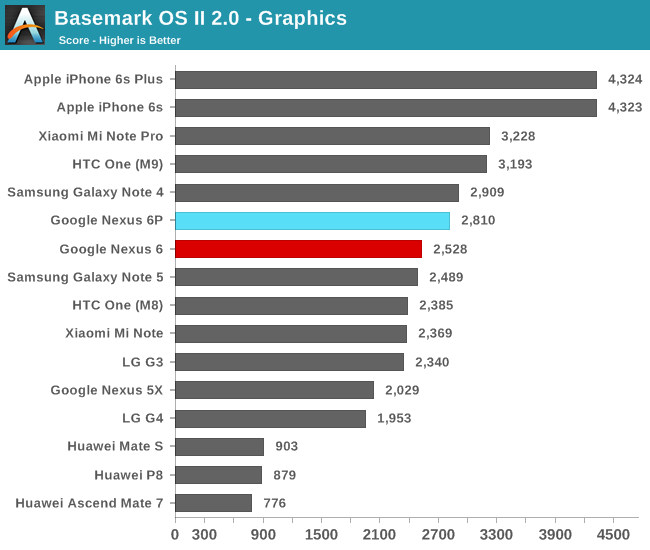
The graphics sub-test of Basemark has always been kind to the Adreno GPU so here again we see the Nexus 6P perform well, although not quite up to par with the other Snapdragon 810 devices we’ve tested in the past.
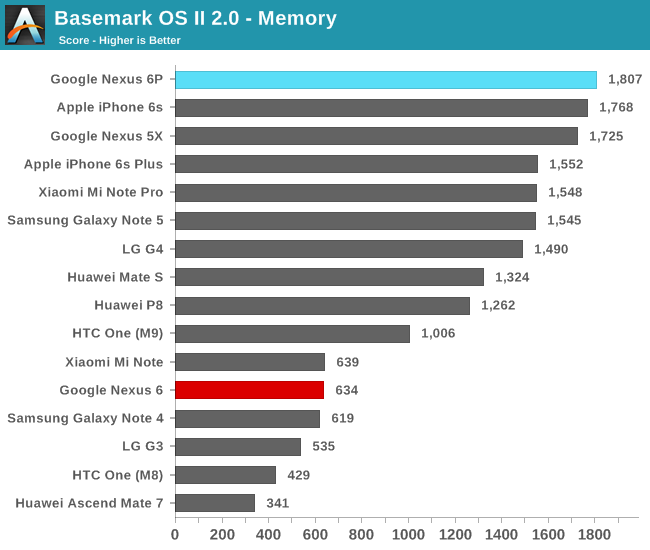
The Nexus 6P comes in a surprising first place on Basemark OS’s memory test. Again this is a mainly NAND-limited test but in contrast to our other synthetic test, performance and access patterns try to simulate more real-world applications.
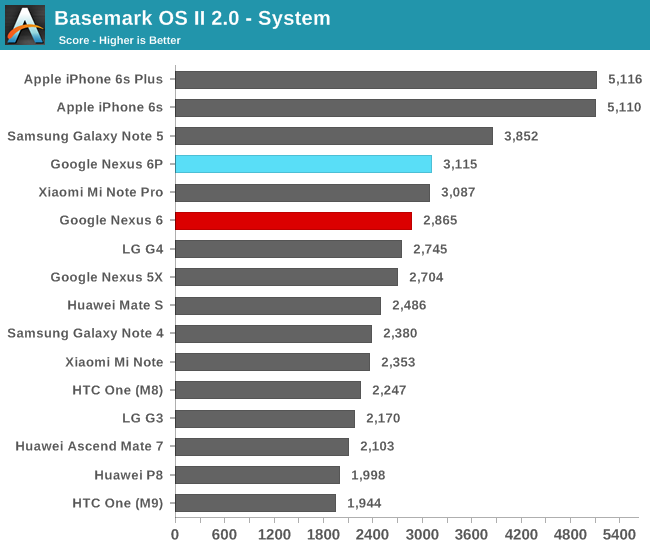
While the other tests try to test more realistic workloads, the system benchmark is all about measuring peak performance in a given set of scenarios. Here the Nexus 6P fares similarly to the Xiaomi Mi Note Pro but falls behind Exynos 7420 devices such as the Note 5.
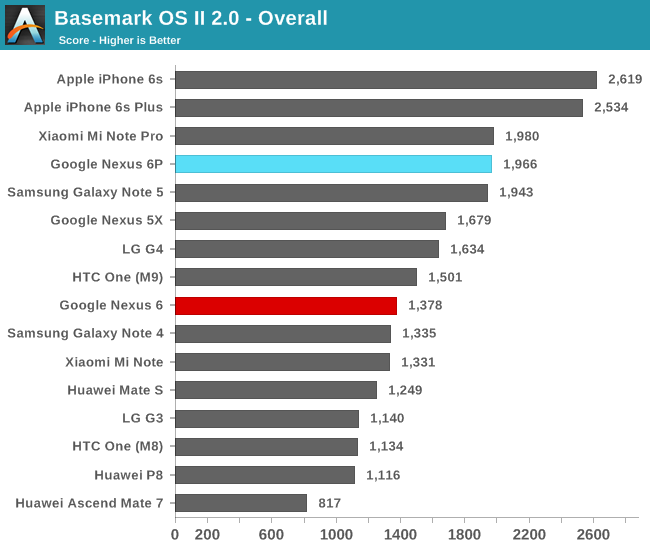
While I’m not a great fan of overall aggregate benchmark scores, we still see the Nexus 6P among the top of today’s currently available Android devices.
Moving on to PCMark from Futuremark, we’ll use a suite of tests that not only try to mimic real-world usage patterns, but actually make use of APIs that we currently find in use by many day-to-day applications.
Starting with the web browsing test we find the application use Android’s built-in WebView container which relies on OS-dependent components.

Here we see the Nexus 6P lead performance, slightly beating the Note 5. We’re also likely seeing advantages due to Android 6.0 as the Mi Note Pro, our other device with the Snapdragon 810 lags over a thousand points behind.
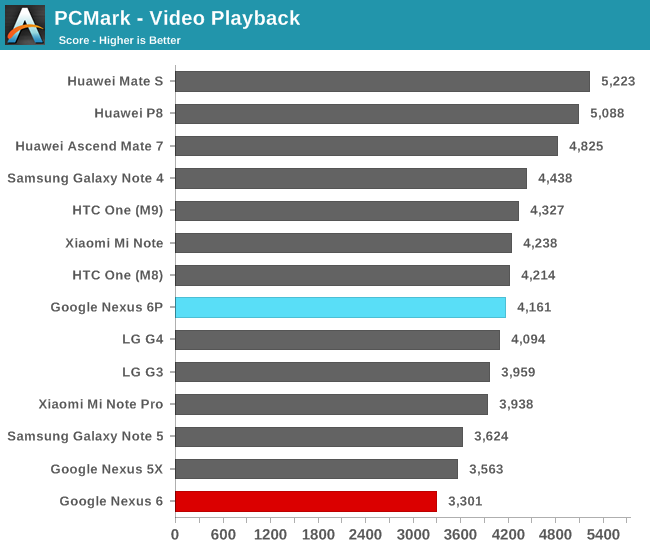
On the video playback score the Nexus 6P comes in towards the middle of the pack. The video test is a benchmark of both the video decoding hardware and software layers of the device, as well as the NAND speed, as fast seeking through the video is performed to test out how rapidly the device can resume playback.
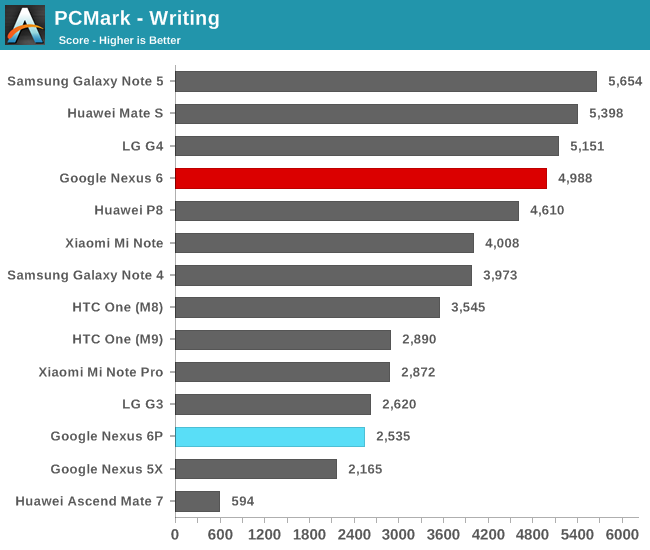
Now onto the writing test we come to one of the larger mysteries of the new Nexus 6’s performance. Both the Nexus 5X and the 6P seem to have large issues with PCMark’s writing test. The test itself consist of text manipulation and some file I/O, but most importantly it’s that this is purely a Java based test. Due to the way Android is architected, this means the code is handled and executed by the Android RunTime (ART). Futuremark have done a fantastic job in creating a test-case which is very sensitive to performance differences in the runtime.
At first when seeing these scores I thought that this was a side-effect of Android 6.0’s new big.LITTLE optimizations (which we’ll get back to in a later section), but even after turning those settings off the scores remained the same. After testing some other Java-based benchmarks I came to the conclusion that this has to be a software issue.
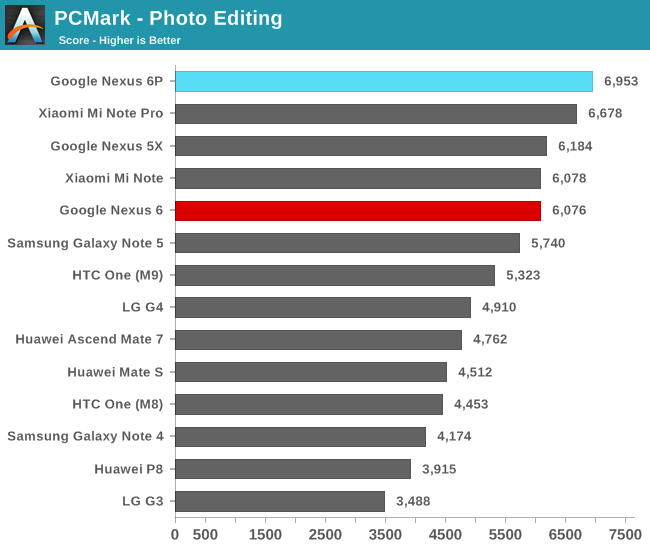
The photo editing uses RenderScript kernels to apply image processing on a set of pictures. With help of a powerful GPU the Nexus 6P performs top of the class
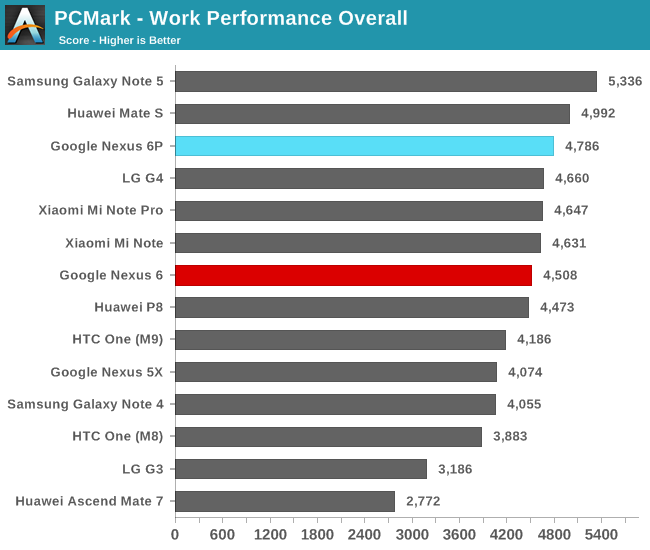
Due to the disappointing writing sub-score the Nexus 6P ends up third in the overall PCMark work performance score. Nevertheless, this is a good showing for the Snapdragon 810 device as it manages to slightly beat the Mi Note Pro and the HTC One M9.










219 Comments
View All Comments
Refuge - Wednesday, December 16, 2015 - link
Thank you! Finally! :DMuch appreciated.
Der2 - Wednesday, December 16, 2015 - link
I cry everytiem when I can't get first.nico_mach - Wednesday, December 16, 2015 - link
Did anyone else find the stock Android complaints puzzling? I switched straight from a tiny iphone 5 to a Nexus 6 and no problems, I think stock Android is a revelation, bright, responsive and with Marshmallow very smooth. I don't use a brightness slider - seems kind of picky. And the back button is, well, fine. It's not like IOS's 'back' button in the upper left is more accessible, right?Finally, there should be gripes about out-of-the-box battery life. Ambient display, Google Now and Location services are too costly in battery to have on by default. Apple ruined music and Google search ruin Android. Irony. At least those can be turned off. Why I have to be prompted about location services when I ask for directions is beyond me - YES turn it back on, I asked for directions!
I can't understand why Google is so keen on defaults that drive people away from Android. It's really very good otherwise. And hopefully they'll fix tablets the way they improved Nexus phones this year.
sleepycujo - Wednesday, December 16, 2015 - link
In fact this is a point most people avoid discussing. I feel it was time somebody brought this up. The stock android feel is exactly what its called. Plain vanilla. Doesnt feel premium and looks just like a 100$ motog(may be lesser). Moreover the simple things you can get used to using OEM skins like swipe to call, message or numerous other features are simply missing unless you root your phone and put in an AOSP Rom with the same look but additional features which is fine on a lower end phone, but shouldnt be necessary on a flagship. I personally think the OEM versions are all upto individual tastes and needs but necessary anyway. LG, Samsung, Huawei and even Mi flavors are what makes Android so loved(and hated!).grayson_carr - Wednesday, December 16, 2015 - link
Lol, swipe to call. I owned a Galaxy S6 earlier this year and hated that feature. I would accidentally activate it when trying to swipe between different tabs (a standard Android interaction) in the dialer app. Not to mention, in the stock Android dialer you just tap to call, which is easier than a swipe. And if you want to message someone, what are you doing in the dialer app? Funny you used that feature as an example because that is exactly the type of feature that annoys me about skins and makes me long for stock Android.lilmoe - Wednesday, December 16, 2015 - link
ExDialer. Never looked back.skavi - Thursday, December 17, 2015 - link
I do that all the time on my S6. God, I hate TouchWiz. Why ruin such an amazing phone with shitty software? Why include 3 fucking gigs of RAM if you don't allow the phone to use it? Just take the good parts (camera app/split screen) and put them on stock Android. Sometimes I feel like they change shit just to change it, even though Google's implementation is clearly better.gochichi - Saturday, February 27, 2016 - link
TouchWiz is clearly a disaster. Until it disappears, I cannot buy another Samsung. Keeping my Note 4 as a little tablet, but I'm just saying no to skins from here forward. Nexus, or iPhone for my phone going forward. It's a real shame. And the lag in updates is plain absurd. No android 6 on S5, S6, Note 4, Note 5... To get android 6 (which is damn old news at this point) get the S7??? Ummm, hell no... Show me some support first. Nexus 5 is smoother phone than Note 4 and when you look at the specs, the only possible explanation is the software is junked up and not even optimized.ACE76 - Wednesday, December 16, 2015 - link
Your implying that there's better availablke in terms of UI from other OEMS? Apple's interface is as boring and "stock" as it gets and doesn't even have a app drawer. Touchwiz is about as ugly and "in your face" as it gets.Devo2007 - Saturday, December 19, 2015 - link
You mean Apple doesn't have a desktop. It's all just an app drawer.....